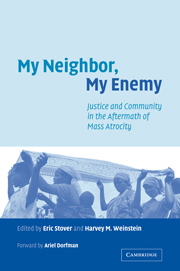Book contents
- Frontmatter
- Contents
- List of contributors
- Foreword by Ariel Dorfman
- Acknowledgments
- Introduction: conflict, justice and reclamation
- Part I Institutional approaches to justice
- 1 A world unto itself? The application of international justice in the former Yugoslavia
- 2 Legal responses to genocide in Rwanda
- 3 Localizing justice: gacaca courts in post-genocide Rwanda
- 4 Exhumation of mass graves: balancing legal and humanitarian needs
- 5 Witnesses and the promise of justice in The Hague
- 6 Reparations in the aftermath of repression and mass violence
- Part II Social reconstruction and justice
- Part III Survivors and justice
- Conclusion: a common objective, a universe of alternatives
- Index
6 - Reparations in the aftermath of repression and mass violence
Published online by Cambridge University Press: 05 May 2010
- Frontmatter
- Contents
- List of contributors
- Foreword by Ariel Dorfman
- Acknowledgments
- Introduction: conflict, justice and reclamation
- Part I Institutional approaches to justice
- 1 A world unto itself? The application of international justice in the former Yugoslavia
- 2 Legal responses to genocide in Rwanda
- 3 Localizing justice: gacaca courts in post-genocide Rwanda
- 4 Exhumation of mass graves: balancing legal and humanitarian needs
- 5 Witnesses and the promise of justice in The Hague
- 6 Reparations in the aftermath of repression and mass violence
- Part II Social reconstruction and justice
- Part III Survivors and justice
- Conclusion: a common objective, a universe of alternatives
- Index
Summary
It is a basic maxim of law that harms should be remedied. Every legal system insists on it, in some form. Under international law, states are obliged to provide remedies for violations of human rights, both as a matter of treaty law and as part of the general rules of state responsibility. Recent United Nations (UN) formulations view restitution, rehabilitation, and compensation as interlinked but distinct state obligations. Not only states must remedy past harms: the statute of the newly created International Criminal Court allows for individual offenders to pay reparations to victims, as well as for the creation of a trust fund to be used where individual awards are impracticable.
Despite these remedies, few reparations have actually been paid to victims of war crimes and human rights abuses in the wake of mass violence. So far, Germany has paid the largest reparations (for Nazi-era crimes). The United States paid reparations to surviving Japanese-American internees, but other claims from the Second World War, like those against Japan for “comfort women” and slave laborers, have fared less well. Outside the context of the Second World War, examples of large-scale reparations programs become scarcer. Chile and Argentina provided compensation, rehabilitation, and services to some (but not all) of the victims of their respective military dictatorships. The UN set up a compensation mechanism for victims of Iraq's invasion of Kuwait, some of whom suffered what could be characterized as violations of human rights.
- Type
- Chapter
- Information
- My Neighbor, My EnemyJustice and Community in the Aftermath of Mass Atrocity, pp. 121 - 140Publisher: Cambridge University PressPrint publication year: 2004
- 20
- Cited by



